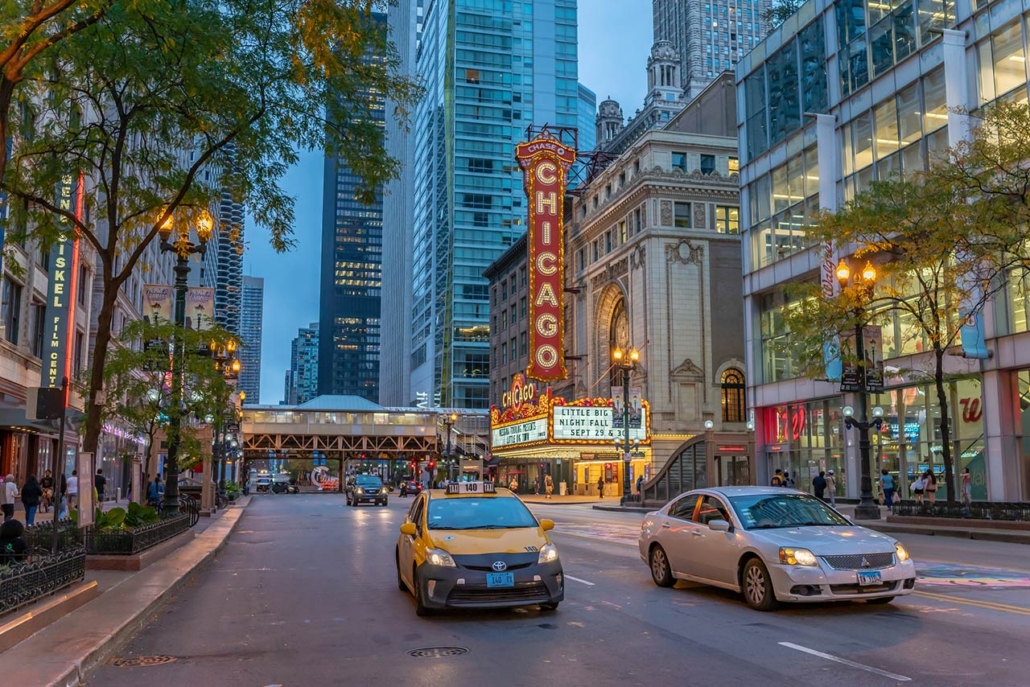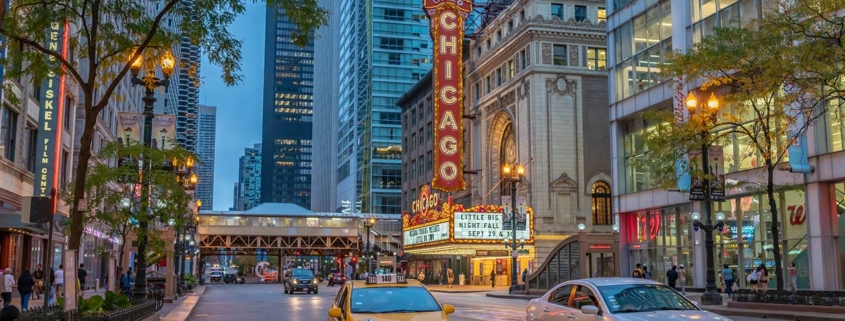Neighborhood News: On State Street, that great street…

“On State Street, that great street, I just want to stay…They do things they don’t do on Broadway…”
Lyrics from ‘Chicago, That Toddlin’ Town,’ by Fred Fisher. Made famous by Frank Sinatra
Today, State Street is known as a bustling business district, educational center, and people-watcher’s paradise. It’s where people gather to see the holiday decorations at Macy’s, television broadcasts at ABC Channel 7, and radio broadcasts at ESPN-1000.
Most of all, State Street stands as a reminder of all Chicago can be, and all that it has been.
History of State Street
According to the Chicago Loop Alliance, the story of State Street began in 1831 when the Illinois legislature officially authorized a State Road connecting Vincennes to Chicago. The name State Street came from this road, which ran along the eastern boundary of Chicago.
During the early 1800s, what we now call the corner of State and Wacker was “the last outpost for shopping for the thousands of emigrants coming from the east going to government lands in Nebraska, Kansas and the Dakotas.” Chicagology makes reference to “squaws in gaudily covered blankets trading for calicos with settlers.”
As a result, State Street became a dynamic, economically strong commercial artery of Chicago.
Boundaries
According to Wikipedia sources, from north to south, State Street traverses the following community areas of Chicago: Near North Side to the Chicago River, Chicago Loop to Roosevelt Road, Near South Side to 26th Street, Douglas to 39th Street, Grand Boulevard to 51st Street, Washington Park to 63rd Street, Grand Crossing to 79th Street, Chatham to 91st Street, Roseland to 115th Street, and West Pullman to 127th Street, where it terminates across from Riverdale Bend Woods.
State Street in the 1860s was, according to the Historical Marker Database, a narrow, unpaved street edged by wooden sidewalks and a confusion of small shops. Potter Palmer, who had been in business with Marshall Field and Levi Leiter in a Lake Street store before the Civil War, purchased a ¾ mile stretch of land along State Street, convincing Field and Leiter to open the street’s first major department store at the northeast corner of State and Washington.
By 1870, State Street had become Chicago’s shopping destination, according to the Historical Marker Database. The next year, widespread destruction caused by the Chicago Fire of 1871 “merely delayed its growth.” Palmer rebuilt promptly, with cutting-edge fire safety features. By the 1890s, State Street was home to Chicago’s finest retail establishments, with more prestigious and expensive stores clustered at the north end and the more popular stores carrying a greater variety of merchandise at the south end.
Wikipedia sources note that Palmer built his own Palmer House Hotel nearby in 1870. The Chicago Theatre, 175 North State Street, became a city entertainment center in 1921. Marshall Field’s was quickly followed by such retail giants as Sears, Roebuck and Co., Charles A. Stevens, and numerous other retailers. In fact, for the next century, the street was the undisputed center of fashion and industry.
When the city’s first subway system was completed under State Street in 1943, it provided for direct pedestrian connections from the mezzanine level stations to the basements of many of the department stores.
However, according to the Chicago Loop Alliance, the post-World War II era brought a new economic landscape as soldiers returned home and started raising families, giving rise to rapid suburban developments. Coupled with the newly-constructed highways, which made commuting to the city easier, the suburbs enticed both residents and businesses away from the bustling city.
An ill-fated State Street Mall
Opened in 1979, the Chicago Loop Alliance told the story of the ill-fated State Street Mall. Though designed to improve the efficiency of the bus system, reduce noise and air pollution, and enhance the shopping experience on State Street, the problems were numerous.
“The State Street Mall did not work out because it cut the street off from the rest of the Loop and took away its excitement,” former CLA member Laura Jones said in a blog. “The car ban meant you couldn’t drop grandma off in front of the Field’s entrance anymore.”
Renaissance to Today
Modern day State Street began with the opening of Block 37 in 2009 at State and Washington, bringing with it a large group of upscale retailers to North State Street, connected on the Pedway level is the Blue Line Washington station and Red Line Lake station. The Chicago Loop Alliance also provides activities such as monthly ‘Sundays on State’ street festivals. DePaul University, Columbia College and Roosevelt University opened branches on the South end of State Street.
A Spook-tacular Parade
On Saturday, October 21, from 6pm-8pm, The Arts in the Dark Halloween Parade runs along State Street, between Lake and Van Buren, and features a wide array of performers, musicians, and artistic floats all decked out in spooky Halloween costumes. The parade has been recognized as one of the top six Halloween events in the world. For more information, click here.
Alison Moran-Powers and Dean’s Team Chicago



